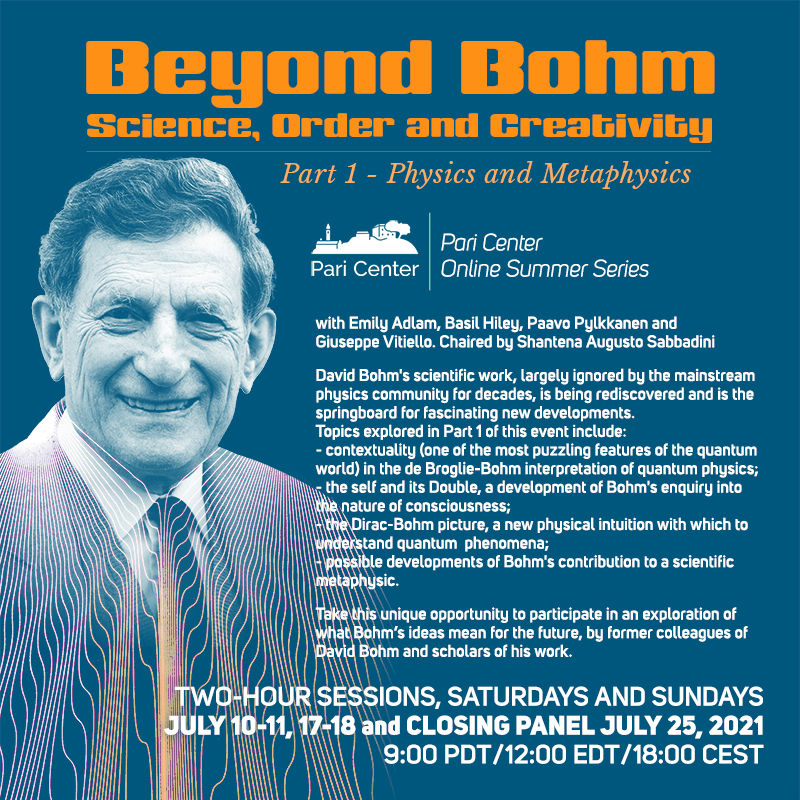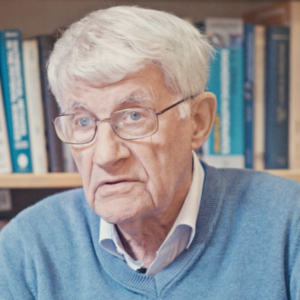Your cart is currently empty!

The Dirac-Bohm Picture: Bohm’s 1952 Approach in a Wider Context
- This event has passed.
July 17, 2021 @ 6:01 pm – 8:00 pm CEST

Buy the recording

The Dirac-Bohm Picture: Bohm’s 1952 Approach In A Wider Context. Basil Hiley
The Dirac-Bohm Picture: Bohm’s 1952 Approach in a Wider Context
with Basil Hiley
Saturday July 17, 2021
9:00 PDT | 12:00 EDT | 17:00 BST | 18:00 CEST
2-hour session
If you are unable to attend the live session, the recording will be available.
It has recently been shown that the Bohm approach outlined in his 1952 work is not a new type of ‘mechanics’ but is unitarily equivalent, i.e. mathematically equivalent, to the Schrödinger approach, dealing directly with canonical coordinates (x, p) rather than through the intermediary ‘wave functions’. This fits in with the Stone-von Neumann theorem which explains why we already have the Schrödinger ‘picture’, the Heisenberg ‘picture’, the interaction ‘picture’ etc. We have called it the Dirac-Bohm ‘picture’ based on a non-commutative algebra: it is from this picture that Bohm’s ’52 approach emerges. The word ‘picture’ is here used in a technical sense, but can be taken as providing a different physical intuition with which to understand quantum phenomena.
Although many of the details are very technical, Hiley will try to explain how the ideas provide a new way of looking at quantum phenomena, which not only confirms Bohm’s philosophical insights, but adds a new meaning to terms like the ‘Bohm momentum’, the ‘osmotic momentum’ which, in turn, enables us to understand how the quantum potential fits in with the general notion of a gauge field. The reason why the quantum potential gives rise to such a ‘strange’ force is that we are looking at it in terms of an interaction force. However it gives rise to a different type of force which Einstein calls a ‘phoronometric’ force. It is the type of potential that generates the Coriolis force which is responsible for the depressions arising in the Atlantic ocean giving us here in the UK such ‘wretched weather’ or the vortices that arise in the Bosporus. What is not generally realised is that the perihelion precession of Mercury arises from just such a force in general relativity. It is this mathematical structure that enables us to generate a new ‘dynamical geometry’ or better still a phoronometry providing new insights into the relation between the individual and the collective.
To see the Full Beyond Bohm Series

Professor Basil Hiley, collaborator and colleague of David Bohm for over 30 years
Basil J. Hiley is a British quantum physicist and professor emeritus of the University of London. He received the Majorana Prize ‘Best Person in Physics’ in 2012. A long-time co-worker of David Bohm, Hiley is known for his work with Bohm on the implicate order and for his work on algebraic descriptions of quantum physics in terms of underlying symplectic and orthogonal Clifford algebras. Hiley co-authored the book The Undivided Universe with David Bohm, which is considered the main reference for Bohm’s interpretation of quantum theory.
The work of Bohm and Hiley has been characterized as primarily addressing the question ‘whether we can have an adequate conception of the reality of a quantum system, be this causal or be it stochastic or be it of any other nature’ and meeting the scientific challenge of providing a mathematical description of quantum systems that matches the idea of an implicate order.
In 1961 Hiley was appointed assistant lecturer at Birkbeck College, where Bohm had taken the chair of Theoretical Physics shortly before. Hiley wanted to investigate how physics could be based on a notion of process, and he found that David Bohm held similar ideas. He reports that during the seminars he held together with Roger Penrose he was particularly fascinated by John Wheeler’s ‘sum over three geometries’ ideas that he was using to quantize gravity.
Hiley worked with David Bohm for many years on fundamental problems of theoretical physics. Initially Bohm’s model of 1952 did not feature in their discussions; this changed when Hiley asked himself whether the ‘Einstein-Schrödinger equation,’ as Wheeler called it, might be found by studying the full implications of that model. They worked together closely for three decades. Together they wrote many publications, including the book The Undivided Universe: An Ontological Interpretation of Quantum Theory, published 1993, which is now considered the major reference for Bohm’s interpretation of quantum theory.
In 1995, Basil Hiley was appointed to the chair in physics at Birkbeck College at the University of London. He was awarded the 2012 Majorana Prize in the category The Best Person in Physics for the algebraic approach to quantum mechanics and furthermore in recognition of ‘his paramount importance as natural philosopher, his critical and open minded attitude towards the role of science in contemporary culture.’
